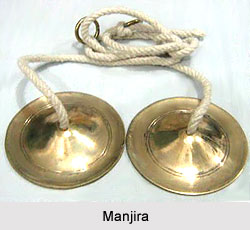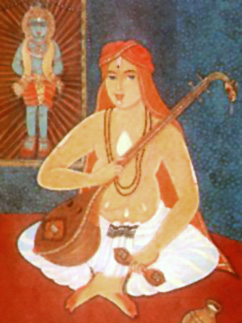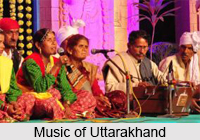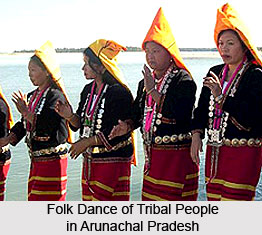The Happy go lucky attitude of the Kuchi have facilitated them to come up with various means for leisure activities. Some of them include drama, games, and story telling, as well as music. Them all these, music plays an integral parts of the entertainment process.
Bhorr & Bhorrinbo
In Kutch, it is known as Bhorrindo, while in other part of Sindh, it is also known as Borrindo or Borendo. Bhorrindo is known in the western world as Ochirina or Ocarina. It is very ancient folk instrument of music. Bhorrindo is a simple hollow clay ball or like an egg shaped with three to four holes, one somewhat larger than others. The holes are arranged in an isosceles triangular form. The Bhorrindo is made out of soft alluvial clay.
The sound notes are produced by blowing somewhat horizontally into the larger hole. Finger tips are placed on the smaller holes to regulate the notes. It is easy to play and hence its popularity among children and young who sound sweet notes on it while grazing the cattle.
Dak or Dakul
Dak or Dakul belongs to the Damru Family. The shape of the Dak or Dakul is similar to the shape of the Damru, but bigger in size sometimes. It is played to create a horrifying atmosphere.
The body of the Dacca or Dakar is made of an hour-glass frame with vellum drum heads. The heads are usually of calf skin, tied to hoops on both sides and braced and tightened with ropes. It is struck only one side either by hand or by stick. The cords are pressed and released in quick succession to give varying degrees to tension to the skinheads effecting changes in tonal sound. The Dak or Dakul is mainly used by the medicants and jugglers of the Bhuva community. These Bhuvas play the Dak or Dakul at the time of elimination of the elements like ghost etc. Dak is also played while Observing tantrik-cult.
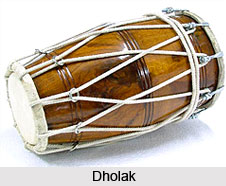 Dholak
Dholak
Dholak is one of the most important folk instruments of membraphonic class. It is used for accompaniment for singing and dancing. As such it is accepted as a percussion instrument for varied kinds of music, from modern film music to simple folk songs and dan.
The shell or the main body of the Dholak is hollowed out of a solid block of wood, over the two usually equal size open ends of the hollowed cylinder; parchment is stretched by tightening cords of braces, through leather hoops on both sides. To achieve tonal variation between the two heads, generally a past of flour and iron filing is fixed on the parchment of the left side to permanently lower the tension of the left side head.
Moreover small circular metal rings, loop or wooden pieces are passed through the braces which can be pulled on either side, to increase or decrease the tension of the heads. The right head is kept in high pitch and the left head is kept in low pitch. It is struck on both sides by the hands, fingers, knuckles and part of the palm. A metal ring is sometime tapped on the shell of the instrument.
Duff
Duff is an important folk instrument of rim-variety. It is an outdoor instrument and is used mainly for accompaniment with folk dance. Duff consists of an open circular frame of wood which is covered with skin on one side. The diameter of the Duff varies from three inches to three feet. Duff can be played either with the hand or with sticks.
The Duff is played on many festive occasions like Holi, Muharram procession etc.
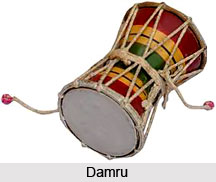 Damaru
Damaru
The origin of the Damru has been attributed to great antiquity and its significance in Indian mythology has been cemented upon by scholars. Damru is associated with Lord Shiva in Hindu mythology. It is said that Lord Shiva played Damru at the time of tandem-nritya. The Damru is also represented as an attribute of Shiva Natraja in ancient sculptures.
The shape of the Damru is like an hour-glass. Its length varies from six inches tom one foot. The body of the instrument is made of wooden hour-glass shaped shell with two skin-heads laced to the body by cotton rope or tarsier thread. A small ball of metal or cork is attached to a string which is bound round the narrow waist of the drum over the braces connecting the two heads.
The Damru is used for accompanying devotional and ritualistic folk music. Generally, it is used by mendicant`s snake charmers, gypsies and jugglers.
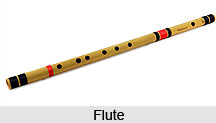 Flute
Flute
Flute is a musical instrument of the woodwind family. Unlike other woodwind instruments, a flute is a reedless wind instrument that produces its sound from the flow of air against an edge, instead of using a reed.
Ghado or Ghaghar
Ghado is baked earthen Jat of an average size. A special variety known as Ghaghar which is made to order is a bigger jar bulging at its sides and having a shorter neck. The clay for Ghado or Ghaghar to be used as a musical instrument, is specially prepared by the expert potter, and is pressed to delicate thickness all over.
Ghado or Ghaghar is arrhythmic instrument. The variety of Tals is manipulated on the side walls and other on the mouth of the jar. Traditionally, Ghado or Ghaghar is played to the accompaniment of Surando.
Jodia Pawa
Jodia Pawa has a significant roll in the rich cultural heritage of Kutch. As we listen to Jodia Pawa, it is natural to understand that Jodia Pawa is a kind of a Bansari - a flute. But in fact it is different from Bansari.
Jodia Pawa is a pair of two flutes or double flutes or double flutes of the same size and length remains about 20 to 22 inches generally played together keeping both the flute in the mouth, One is called Nar- the male and the other is called Madi or Mali - the female.Nar has eight equi-distant holes for maintaining a drone or Sur.The Madi weaves the melody on this base over twelve holes on top on which fingers move. Of the twelve holes of the Madi, only the upper six are used functionally to manipulate music while the lower six are left open and free. There are some artists of Jodia Pawa in Kutch at this time. Among them Shri Musa Jat is superior to all.
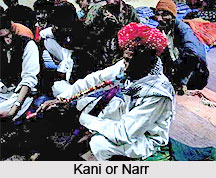 Kani or Narr
Kani or Narr
Kani ro Narr (per. Nai) has been the common traditional instrument of Kutch and Sind, Baluchistan of Pakistan, and of Iran and Turkey.
In Sindhi, Narr is the generic name for all kinds of reed plants, the stalks of which are hollowed or can be hollowed by removing the pulp from inside. The Narr instrument is made from what is known as `sacho narr (the genuine reed) ore kangore which grows shere water is permanently available. The valley of the Kech River in the Makran District (of Baluchistan) produces one of the best varieties of the reed which has supplied the instrument for the regions of Pakistan and also to Iran and Turkey.
In Kutch, Narr or Kani is not so familiar to the public as there are only three performers of it at the moment, and they play only on some religious occasions, fairs and festivals.
Khanjari
This is a wooden drum-like instrument made in various sizes.
Jhanjh
Manjira is the smallest in metal clappers series. It is a pair of small and deep metallic cymbals, which are made of bronze or brass metal.
Murli
murli, the snake charmer`s instrument, is mentioned in this connection; this wind instrument can indeed produce strange effects by its heart rendering sound.
Morchang.
The morchang resembles a jew`s-harp. The plaintive, melancholic twang of the morchang adds a desolate dimension to the songs of the Manganiyars.
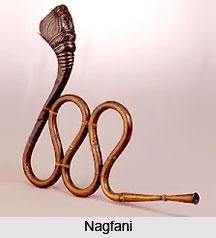 Nagfani
Nagfani
The Nagfani is an ordinary wavy pipe made of brass or bronze. The shape of this pipe is like Nal is used for accompaniment with folk dancing and singing. The Nal is a long cylindrical two faced drum tape ring on one side. The ring head parchment, pasted with iron filing is mounted on the body and held by hoops at both ends and fastened by rope. The left head is low pitched and is pasted from inside. The narrow head of the left side and its method of holding the parchment give the drum it`s bright and clear tone.
Nal
Nal is used for accompaniment with folk dancing and singing. The Nal is a long cylindrical two faced drum tape ring on one side. The ring head parchment, pasted with iron filing is mounted on the body and held by hoops at both ends and fastened by rope. The left head is low pitched and is pasted from inside. The narrow head of the left side and its method of holding the parchment give the drum it`s bright and clear tone.
Nagara or Nobat
They are kettledrums of old Nobat (traditional ensemble of nine instruments). We have a same instrument in India that its name is Nagada or Nagara to be usually accompanied with the Shehnay.
Santor
Santor is a primitive form of a Sitar played while chanting and singing folk lores, religious songs, etc. It is also known as `Ram Sagar`.
Sharnai
Sharnai is an old indigenous double reeded instrument. In olden times, Sharnai or Shenai was also known as Karnai, Nafeeri, Tota. Sharnai is a vibration of Surnai and these words Surnai, Karnai, Tota are of Persian origin meaning a trumpet, clarion or a bugle.
The body of the Sharnai is made from the wood of a very old Kirarr tree. Sharnai is of the medium size about eight inches long and it is essentially the musical instrument of the Lower Indus Valley The Sharnai is used on ceremonial occasions and it is considered as an auspicious instrument or mangala- vadya, Sharnai is now played by the Langa community a family of traditional music in Kutch for years.
Sundari
Sundari is a double reed wind instrument. It resembles the Sharnai in shape and construction, but it is shorter than the Sharnai. A Sundari has seven to nine holes made of shisam on lathe. The method of playing the Sundari is similar to that of playing the Sharnai. The other main difference is that Sundari is always played in medium and fast tempo; alap, gamaka, mind etc. of slow tempo are not possible in Sundari because it is a very short and tiny instrument, so most of the time, the raga (like sohini, adana etc.) which are played in the notes of tara saptaka are played on the Sundari.
Surando
Surando is an ancient folk musical instrument of Kutch. Surando is a stringed musical instrument played with the use of Bow, Gaz or Gazi in local dialect. The body of the instrument is made of all sorts of wood.
